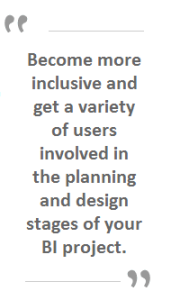Deploying Business Intelligence
Business intelligence, also commonly referred to as BI throughout the industry, is a piece of technology that allows a business to obtain actionable information that they can then use throughout their day-to-day operations. While business intelligence solutions certainly have their fair share of advantages, it is also important to realize that they are not the be-all, end-all solution for guidance that many people think they are.
There are certain business intelligence deployment misconceptions that businesses make over and over again to their detriment. Understanding these misconceptions will allow you to successfully avoid them and use BI to its fullest potential.
The Benefits of Business Intelligence
- The information provided is accurate, fast and, most importantly, visible to aid with making critical decisions relating to the growth of a business, as well as its movement.
- Business intelligence can allow for automated report delivery using pre-calculated metrics.
- Data can be delivered using real-time solutions that increase their accuracy and reduce the overall risk to the business owner.
- The burden on business managers to consolidate information assets can be greatly reduced through the additional delivery and organizational benefits inherent in the proper implementation of business intelligence solutions.
- The return on investment for organizations with regard to business intelligence is far-reaching and significant.
Business Intelligence Deployment Misconceptions
 One of the most prevalent misconceptions about business intelligence deployment is the idea that the systems are fully automated right out of the box. While it is true that the return on investment for such systems can be quite significant, that is only true if the systems have been designed, managed and deployed properly.
One of the most prevalent misconceptions about business intelligence deployment is the idea that the systems are fully automated right out of the box. While it is true that the return on investment for such systems can be quite significant, that is only true if the systems have been designed, managed and deployed properly.
A common misconception is that a single business intelligence tool is all a company needs to get the relevant information to guide themselves into the next phase of their operations. According to Rick Sherman, the founder of Athena IT Solutions, the average Fortune 1000 company implements no less than six different BI tools at any given time.
All of these systems are closely monitored, and the information provided by them is then used to guide the business through its operations. No single system will have the accuracy, speed or power to get the job done on its own.
Another widespread misconception is the idea that all companies are using business intelligence in the present term and your company has all the information it needs in order to stay competitive. In reality, only about 25 percent of all business users have been reported as using BI technology in the past few years. The 25% number is actually a plateau – growth has been stagnant for some time.
One unfortunate misconception involves the idea that “self-service” business intelligence systems indicate that you only need to give users access to the available data to achieve success. In reality, self-service tools often need additional support than what most people plan for.
This support is also required on a continuing basis in order to prevent the systems from returning data that is both incomplete and inconsistent.
One surprising misconception about the deployment of business intelligence is that BI systems have completely replaced the spreadsheet as the ideal tool for analysis. In truth, many experts agree that spreadsheets are and will continue to be the only pervasive business intelligence tool for quite some time.
Spreadsheets, when used to track the right data and perform the proper analysis, have uses that shouldn’t be overlooked. Additionally, business users that find BI deployment too daunting or unwieldy will likely return to spreadsheets for all of their analysis needs.
According to the website Max Metrics, another common misconception is that business intelligence is a tool that is only to be used for basic reporting purposes.
In reality, BI can help business users identify customer behaviors and trends, locate areas of success that may have previously been overlooked and find new ways to effectively target a core audience. BI is a great deal more than just a simple collection of stats and numbers.
For more on this topic, check out our series, “What is business intelligence?“
